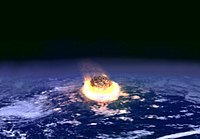
Photo from wikipedia
Isolated teeth, previously referred to Aves, are more common than other bird fossils from the Late Cretaceous of Alberta. However, there are no known morphological synapomorphies that distinguish isolated bird… Click to show full abstract
Isolated teeth, previously referred to Aves, are more common than other bird fossils from the Late Cretaceous of Alberta. However, there are no known morphological synapomorphies that distinguish isolated bird teeth, and features of these teeth are generally shared with those of non-avian theropods and crocodilians. Here, specimens ranging from Late Santonian to Late Maastrichtian in age are described and qualitatively categorized into morphotypes, most of which strongly resemble teeth of extant juvenile and some fossil crocodilians. Variation within this sample of teeth may therefore reflect the heterodont dentition of crocodilians, rather than avian species diversity. Quantitative analysis Principal Component Analysis was mostly uninformative, with limited overlap between putative avian teeth and those of known Cretaceous birds, crocodilians, and non-avian theropods. The reassignment of these putative avian teeth to Crocodylia has important ramifications for our understanding of the evolutionary history of Cretaceous birds.
Journal Title: PLOS ONE
Year Published: 2023
Link to full text (if available)
Share on Social Media: Sign Up to like & get
recommendations!